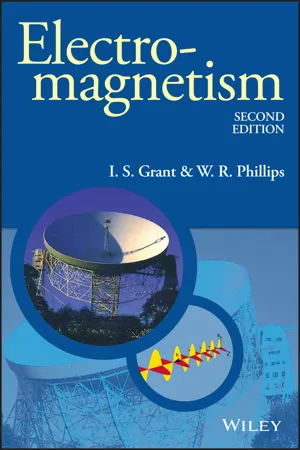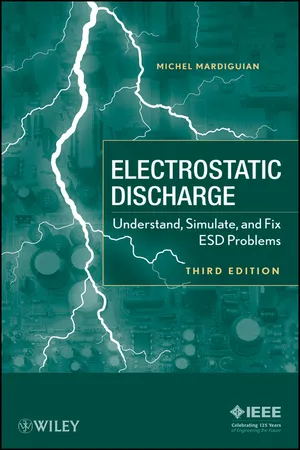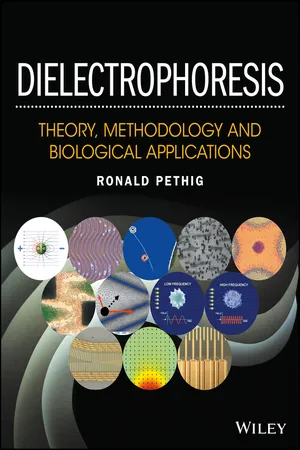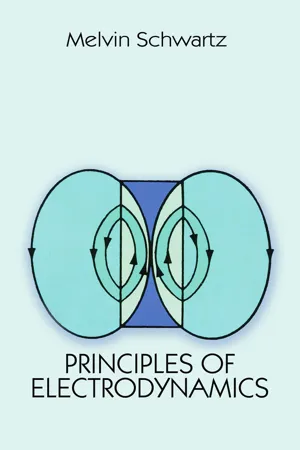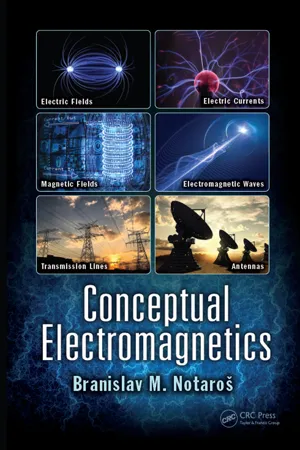Physics
Induced Surface Charge
Induced surface charge refers to the redistribution of electric charge on a conductor's surface when it is brought near a charged object. This redistribution occurs due to the influence of the external electric field, leading to the separation of positive and negative charges on the surface. The induced surface charge creates an electric field that opposes the external field, resulting in electrostatic equilibrium.
Written by Perlego with AI-assistance
Related key terms
Related key terms
1 of 4
Related key terms
1 of 3
7 Key excerpts on "Induced Surface Charge"
- eBook - ePub
- I. S. Grant, W. R. Phillips(Authors)
- 2013(Publication Date)
- Wiley(Publisher)
Induced Surface Charge densities ± σ generate an equal and opposite field inside the conductor, where the macroscopic electric field must be zero. Now imagine a disc enclosing an area δS of the surface, as shown in the figure. The flat surfaces of the disc are parallel to the conducting surface while the curved surface is parallel to the external field. The flux E · δ S out of the flat surface of the disc which is outside the conductor is EδS since the vectors E and δ S point in the same direction. Inside the conductor the field is zero, and there is no flux out of the other flat surface of the disc; nor is there any flux out of the curved surface, since the field lies along this surface. The total charge enclosed by the disc is σδS, and application of Gauss’ law leads to (1.16) Figure 1.15. A disc enclosing some of the induced charge on a conductor. The example of a slab placed perpendicular to an external field is a special case, but it is easy to show that the induced charges are disposed in such a way that the electric field is always perpendicular to the surface. For if there were a component of the field parallel to the surface, conduction electrons would move until they set up a field which exactly cancelled this component. Over a small part of a conducting surface of any shape, the argument given above is valid, and Equation (1.16) holds at each point of the surface, whether or not it is plane. Since macroscopic electric fields are limited to a maximum value of about 10 9 volts m −1, it follows that practically realizable surface charge densities are less than 10 9 ε 0 10 −2 coulomb m −2. Atomic diameters are about 2 × 10 −10 m, and the area associated with each atom on the surface of a conductor is about 4 × 10 −20 m 2. The maximum surface charge thus corresponds to 4 × 10 −22 coulombs, or less than a hundredth of the electronic charge, for each surface atom - eBook - ePub
- Huixia Luo(Author)
- 2019(Publication Date)
- Wiley-Scrivener(Publisher)
According to the disorder degree, there is a competition between the conductivity caused by the mobility in the extended states and the conductivity induced by the mobility in the localized states (at the bottom of the conduction band). For a low degree of disorder, the conductivity of the electrons is mainly given by that of the electrons injected into the extended states. For a high degree of disorder, the conductivity is mainly given by that of the injected electrons in the localized states. The main result is that for a certain number of insulators and from a certain degree of disorder the conduction in the localized states is activated at ambient temperature [23].8.5.5 Space Charge
The materials used in electrical insulation never behave as perfect insulators. They tend to trap a charge by mechanisms described theoretically in some idealized situations.In the concrete situations encountered in industrial applications, it is difficult or even impossible to have a theoretical approach as the systems are complex and often not well-defined at the microscopic level. It is therefore essential, in the context of an application, to carry out tests according to techniques allowing the measure of the generated charge for given experimental conditions.The set of real charges is called space charge, whether positive or negative contained in an insulator, which includes the surface and volume charges. The volume density of these charges is designed by ρc which is assumed as a variable only in the z direction. The Poisson equation is written [23]:(8.3)where D(z) is the electric displacement and ρ(z) is the total charge density,Including therefore the polarization charge ρp (z) defined relative to the polarization P(z) of the material by:(8.4)When the polarization is uniform according to z, the total charge is reduced to the space charge.The different techniques for measuring the trapped charges in an insulator are sensitive to the set of charges, whatever their origin is. The space charge and the polarization charge are therefore measured without being able to dissociate them. Decoupling can only take place through a consideration of the physical laws governing the two phenomena. - eBook - ePub
Electro Static Discharge
Understand, Simulate, and Fix ESD Problems
- Michel Mardiguian(Author)
- 2011(Publication Date)
- Wiley-IEEE Press(Publisher)
Chapter 1 The Electrostatic Discharge PhenomenonA lthough a thorough description of the electrostatic phenomenon is beyond the scope of this book and has been covered by several authors (1–4), it might be useful to start by reviewing briefly how static electricity takes place, what are the contributing parameters, and why, eventually, it ends abruptly in its threatening consequence: the electrostatic discharge (ESD).The following section is an extremely simplified view of the electrostatic charging mechanisms. While clearly not a treatise on static electricity, it illustrate the physics involved, in a simple manner. Readers with a good basic knowledge of electrostatics can probably skip this preliminary portion.1.1. PHYSICS INVOLVEDAny material is made of atoms. Unless submitted to certain external influences (heating, rubbing, electrical stress, etc.), the atom is at equilibrum; that is, the amount of negative charges represented by the electrons orbiting around the nucleus is exactly balanced by an equal number of positive charges or protons aggregated in the nucleus. Therefore, the net electric charge seen from the ouside is zero.In good conductors, the mobility of electrons is such that the conditions of equilibrium will always exist; that is, no significant static field will exist between different zones of the same piece of metal. With nonconductive materials, how-ever, the lesser mobility of electrons does not provide such a rapid recombination of charge unbalance. If heated, or rubbed strongly (which also creates heat), a nonconductor will free up electrons.Depending on the nature of its outer valence orbit, a nonconductive material may be likely to give up electrons or to capture wandering electrons.Figure 1.1If by heating, rubbing, and the like, one electron is leaving the orbit, the material is left with six protons and only five electrons.A nonconductive material that gives up an electron, as shown in Figure 1.1 , will become positively charged. Such unbalanced atoms with a lack of electrons are called positive ions . A nonconductive material that takes extra electrons will become negatively charged, and its atoms with excess electrons are called neg-ative ions - eBook - ePub
Dielectrophoresis
Theory, Methodology and Biological Applications
- Ronald R. Pethig(Author)
- 2017(Publication Date)
- Wiley(Publisher)
0 between two oppositely charged metal plates in vacuum is given by:(3.2)where σ is the uniform free charge density per unit area on each metal plate and o is the permittivity of vacuum. From Equation (3.2 ) the apparent free surface charge density (σ1 ) on each plate when the dielectric is fully inserted is equal to E1 0 . Employing Equation (3.1 ) to substitute for E1 , the reduction Δσ in apparent free surface charge density that occurs on inserting the dielectric between the plates is calculated to be:(3.3)Clearly, even though free charges cannot leak through the dielectric, the material property we have defined as the relative permittivity r is capable of neutralizing some of the free surface charge applied to the metal plates. The physical process responsible is the appearance of polarization charges produced by the dielectric. These polarization charges do not contribute to the measured voltage across the capacitor, but each one neutralizes a free charge on an electrode surface. We say that a free electronic charge has become a bound charge. The basic nature of this process is revealed in the derivation of Equation (3.34 ) and later in this chapter. It is an importance aspect of dielectrophoresis.The practical application of the electrode system shown in Figure 3.1 is as a capacitor (also called a condenser) – a device for storing electrostatic potential energy. As described in section 3.5, this ability is quantified as its capacitance C, the amount of charge it can store at each electrode per unit of voltage applied across the electrodes. (We specify ‘at each electrode’ because the bound charges at opposite electrodes are equal in magnitude but opposite in polarity. The net charge stored in the capacitor is thus zero.) The stored charge at each electrode is the polarization charge of the dielectric, the amount of which is directly proportional to the reduction of voltage shown in Figure 3.1 . The ratio C1 /C0 - eBook - ePub
- Melvin Schwartz(Author)
- 2012(Publication Date)
- Dover Publications(Publisher)
20 tons! A more relevant illustration (suggested to the author by Prof. D. A. Bromley) is the fact that if all the electrons were removed from one-tenth of a cubic millimeter of the material on the nose cone of an Apollo rocket in some unspecified manner and brought down to the pad, the attraction between these electrons and the remaining positive charges on the nose cone would be sufficient to anchor the rocket firmly in place despite full thrust from the first stage. Remarkable indeed! We see thus that the fraction of available electrons which are involved when we charge or discharge an object is infinitesimal.Some materials have the property that all their electron clouds are quite strongly bound to the individual positive nuclei. In this case the application of a reasonable local electric field within the material serves only to stretch the bonds between electrons and individual nuclei and not to break them. As we shall learn shortly, the material is then polarized but no real current flows. Such materials are called dielectrics.Within some materials, called conductors, the application of an electric field causes the outermost electrons about each nucleus to move relatively freely from atom to atom and to continue moving as long as any field remains within the conductor. If our conductor is isolated, then the moving charge will pile up somewhere until it just neutralizes the applied field within the conductor. At that point no further charge will flow. (There is a tacit assumption here that the momentum picked up by the electrons as they accelerate can be ignored. This assumption is valid because each electron can only accelerate for a very short time before colliding with an atom.)The fact that the electric field within a conductor is zero in static equilibrium permits us to deduce that the charge density is zero within the conductor [see Eq. (2-2-3) ]. Hence whatever charge has piled up must be on the surface of the conductor.Let us apply some of what we have just learned to the solution of a simple problem. We have two concentric conducting spheres, as shown in Fig. 2-3 . The inner sphere has inner radius a and outer radius b. The outer sphere has inner radius c and outer radius d. We place a charge Q1 on the inner sphere and a charge Q2 on the outer sphere. We would like to know how the charge is distributed and what the value of electric field is at every point in space. We let σa , σb , σc , and σd be the unknown surface charge densities per unit area on the surfaces with radii a, b, c, and d - eBook - ePub
- Michael M. Mansfield, Colm O'Sullivan(Authors)
- 2020(Publication Date)
- Wiley(Publisher)
17 Electric fields in materials; the capacitorAIMS
- to investigate the behaviour of electric charges within and in the neighborhood of conducting materials
- to understand the response of non‐conducting (dielectric) materials to electric fields
- to explore some properties of permanently polarised materials
- to introduce the capacitor, an important component of many electrical circuits
- to show how energy is stored in a capacitor
- to understand what happens when a capacitor is charged or discharged through a resistor
17.1 Conductors in electric fields
In electrostatics the electric field strength within the body of a conductor must always be zero since, if such a field existed, it would have the effect of moving the mobile charges to positions where the electric field, and hence the force on them, would be zero. Thus, there can be no net mobile charge anywhere within the body of a conductor since this would give rise to an electric field; hence all excess charge must reside on the surface of a conductor. The distribution of these charges on the surface of a conductor, therefore, must be such that the net effect is to produce zero electric field everywhere inside the conductor.Consider the case of a body made from a good conductor (such as a metal) placed in an electric field as illustrated in Figure 17.1 . Once the external field is switched on, the mobile charges are driven to the surface and are distributed so that the electric field within the conductor is maintained at zero as required. The electric field lines on the left of the body terminate on the negative charges induced on the surface while the positive charges on the other side of the slab act as sources of field lines on that side.Figure 17.1 - eBook - ePub
- Branislav M. Notaroš(Author)
- 2017(Publication Date)
- CRC Press(Publisher)
ELECTROSTATIC FIELD IN DIELECTRICS IntroductionDielectrics or insulators are nonconducting materials, having very little free charges inside them (theoretically, perfect dielectrics have no free charges). However, another type of charge, called bound or polarization charges, exist in a polarized dielectric, as atoms and molecules in the dielectric behave like microscopic electric dipoles. In electrostatic systems containing both conductors and dielectrics, the equivalent electric-field sources are both free and bound charges, considered to reside in free space. By introducing the concept of dielectric permittivity, we are left, in turn, to deal with free charges in the system only, while the contribution of bound charges to the field is properly added through the permittivity. In continuation, we analyze capacitors and transmission lines, composed of both conductors and dielectrics, to evaluate and discuss their capacitance, energy, and breakdown characteristics, as a culmination of our study of the theory and applications of the electrostatic field.2.1 Polarization of DielectricsEach atom or molecule in a dielectric is electrically neutral. For most dielectrics, centers of “gravity” of the positive and negative charges in an atom or molecule coincide – in the absence of the external electric field. When a dielectric is placed in an external field, of intensity E, however, the positive and negative charges shift in opposite directions against their mutual attraction, and produce a small electric dipole. The moment of this equivalent dipole is given by p = Qd, where Q is the positive charge of the atom or molecule (−Q is the negative charge), and d is the vector displacement of Q with respect to −Q. The charges are displaced from their equilibrium positions by forces [Eq. (1.3) ] Fe1 = QE and Fe2 = −QE, respectively. The displacement d is very small, on the order of the dimensions of atoms and molecules. The charges Q and −Q are bound in place by atomic and molecular forces and can only shift positions slightly in response to the external field. So, the two charges in an equivalent small dipole cannot separate one from the other and migrate across the material in opposite directions run by the electric field. Hence, these charges are called bound charges (in contrast to free charges). Some dielectrics, such as water, have molecules with a permanent displacement between the centers of the positive and negative charge, so that they act as small electric dipoles even with no applied electric field. According to Figure 2.1 , the torques (moments) of forces Fe1 and Fe2 with respect to the center of the dipole (point O) are T1 = r1 × Fe1 and T2 = r2 × Fe2 , with r1 and r2 denoting the position vectors of Q and −Q with respect to the dipole center. We notice that r1 − r2 = d
Index pages curate the most relevant extracts from our library of academic textbooks. They’ve been created using an in-house natural language model (NLM), each adding context and meaning to key research topics.
Explore more topic indexes
Explore more topic indexes
1 of 6
Explore more topic indexes
1 of 4
